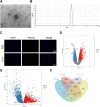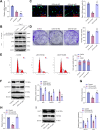Antitumorigenic potential of Lactobacillus-derived extracellular vesicles: p53 succinylation and glycolytic reprogramming in intestinal epithelial cells via SIRT5 modulation
- PMID: 39110260
- PMCID: PMC11306434
- DOI: 10.1007/s10565-024-09897-y
Antitumorigenic potential of Lactobacillus-derived extracellular vesicles: p53 succinylation and glycolytic reprogramming in intestinal epithelial cells via SIRT5 modulation
Abstract
Objective: Colorectal cancer progression involves complex cellular mechanisms. This study examines the effects of Lactobacillus plantarum-derived extracellular vesicles (LEVs) on the SIRT5/p53 axis, focusing on glycolytic metabolic reprogramming and abnormal proliferation in intestinal epithelial cells.
Methods: LEVs were isolated from Lactobacillus plantarum and incubated with Caco-2 cells. Differential gene expression was analyzed through RNA sequencing and compared with TCGA-COAD data. Key target genes and pathways were identified using PPI network and pathway enrichment analysis. Various assays, including RT-qPCR, EdU staining, colony formation, flow cytometry, and Western blotting, were used to assess gene expression, cell proliferation, and metabolic changes. Co-immunoprecipitation confirmed the interaction between SIRT5 and p53, and animal models were employed to validate in vivo effects.
Results: Bioinformatics analysis indicated the SIRT5/p53 axis as a critical pathway in LEVs' modulation of colorectal cancer. LEVs were found to inhibit colorectal cancer cell proliferation and glycolytic metabolism by downregulating SIRT5, influencing p53 desuccinylation. In vivo, LEVs regulated this axis, reducing tumor formation in mice. Clinical sample analysis showed that SIRT5 and p53 succinylation levels correlated with patient prognosis.
Conclusion: Lactobacillus-derived extracellular vesicles play a pivotal role in suppressing colonic tumor formation by modulating the SIRT5/p53 axis. This results in decreased glycolytic metabolic reprogramming and reduced proliferation in intestinal epithelial cells.
Keywords: Lactobacillus; Colorectal cancer; Extracellular vesicles; Palmitoylation modification; SIRT5; p53.
© 2024. The Author(s).
Conflict of interest statement
The authors declare no competing interests.
The author declares no conflict of interest.
Figures








Similar articles
-
Emerging roles of mitochondrial sirtuin SIRT5 in succinylation modification and cancer development.Front Immunol. 2025 Jan 29;16:1531246. doi: 10.3389/fimmu.2025.1531246. eCollection 2025. Front Immunol. 2025. PMID: 39944690 Free PMC article. Review.
-
Transcription factor LHX9 (LIM Homeobox 9) enhances pyruvate kinase PKM2 activity to induce glycolytic metabolic reprogramming in cancer stem cells, promoting gastric cancer progression.J Transl Med. 2023 Nov 18;21(1):833. doi: 10.1186/s12967-023-04658-7. J Transl Med. 2023. PMID: 37980488 Free PMC article.
-
Repression of p53 function by SIRT5-mediated desuccinylation at Lysine 120 in response to DNA damage.Cell Death Differ. 2022 Apr;29(4):722-736. doi: 10.1038/s41418-021-00886-w. Epub 2021 Oct 12. Cell Death Differ. 2022. PMID: 34642466 Free PMC article.
-
SIRT5 promote malignant advancement of chordoma by regulating the desuccinylation of c-myc.BMC Cancer. 2024 Mar 26;24(1):386. doi: 10.1186/s12885-024-12140-w. BMC Cancer. 2024. PMID: 38532359 Free PMC article.
-
Functions of the sirtuin deacylase SIRT5 in normal physiology and pathobiology.Crit Rev Biochem Mol Biol. 2018 Jun;53(3):311-334. doi: 10.1080/10409238.2018.1458071. Epub 2018 Apr 11. Crit Rev Biochem Mol Biol. 2018. PMID: 29637793 Free PMC article. Review.
Cited by
-
Gut microbiota shapes cancer immunotherapy responses.NPJ Biofilms Microbiomes. 2025 Jul 25;11(1):143. doi: 10.1038/s41522-025-00786-8. NPJ Biofilms Microbiomes. 2025. PMID: 40715107 Free PMC article. Review.
-
Harnessing microbial nanobiotics: Lactobacillus extracellular vesicles as next-generation therapeutics across physiological systems.World J Microbiol Biotechnol. 2025 Jul 11;41(7):261. doi: 10.1007/s11274-025-04481-w. World J Microbiol Biotechnol. 2025. PMID: 40640466 Review.
-
Targeting sirtuins for cancer therapy: epigenetics modifications and beyond.Theranostics. 2024 Oct 14;14(17):6726-6767. doi: 10.7150/thno.100667. eCollection 2024. Theranostics. 2024. PMID: 39479446 Free PMC article. Review.
-
Extracellular Vesicle-Based Drug Delivery Systems in Cancer Therapy.Int J Mol Sci. 2025 May 19;26(10):4835. doi: 10.3390/ijms26104835. Int J Mol Sci. 2025. PMID: 40429976 Free PMC article. Review.
-
Emerging roles of mitochondrial sirtuin SIRT5 in succinylation modification and cancer development.Front Immunol. 2025 Jan 29;16:1531246. doi: 10.3389/fimmu.2025.1531246. eCollection 2025. Front Immunol. 2025. PMID: 39944690 Free PMC article. Review.
References
Publication types
MeSH terms
Substances
Grants and funding
LinkOut - more resources
Full Text Sources
Medical
Research Materials
Miscellaneous

